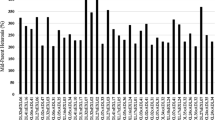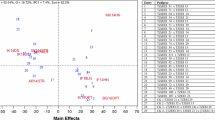Abstract
Low temperatures are important for the production of spring maize in northern China. While the low-temperature tolerance of maize seeds can be improved by coating them, this can result in environmental pollution, high costs, and instability. Therefore, identifying new varieties of maize is the most effective method of improving the ability of maize crops to withstand low temperatures. In this experiment, four low-temperature tolerant maize inbred lines (DNF266, Zhong 451, B73, Dan 340) and four low-temperature sensitive maize inbred lines (Luyuan 92, Ji 853, Huangzaosi, Si 144) were selected from the northern spring maize area. The griffing double-row hybridization design method was used to prepare 28 hybrid combinations. After analysing the general combining ability and the special combining ability of each combination, we found that the indoor low-temperature index and low-temperature seedings were extremely similar for all combinations. The hybridization and parental inbred lines were subjected to low-temperature treatments under both laboratory conditions and in the field. Several low-temperature indexes were assessed to identify what results could be produced from combining them. Under both treatments, the inbred line DNF266 had a higher general combining ability and the Zhong 451 × Dan 340 hybrid combination had a higher special combining ability. These results provide technical support for breeding new low-temperature varieties of maize.


Similar content being viewed by others
References
Badu-Apraku B, Oyekunle M, Akinwale RO, Aderounmu M (2013) Combining ability and genetic diversity of extra-early white maize inbreds under stress and nonstress environments. Crop Sci 53:9–26. https://doi.org/10.2135/cropsci2012.06.0381
Baker RJ (1978) Issues in diallel analysis. Crop Sci 18:533–536. https://doi.org/10.2135/cropsci1978.0011183X001800040001x
Betrán FJ, Ribaut JM, Beck D, Gonzalez de León D (2003) Genetic diversity, specific combining ability, and heterosis in tropical maize under stress and nonstress environments. Crop Sci. https://doi.org/10.2135/cropsci2003.7970
Bouis HE, Ross WM (2010) Biofortification-A sustainable agricultural strategy for reducing micronutrient malnutrition in the global south. Crop Sci 50:20–32. https://doi.org/10.2135/cropsci2009.09.0531
Brandolini A, Landi P, Monfredini G, Tano F (2000) Variation among Andean races of maize for cold tolerance during heterotrophic and early auto-trophic growth. Euphytica 111:33–41. https://doi.org/10.1023/a:1003710431416
Derera J, Pangirayi T, Bindiganavile SV, Mark DL (2007) Gene action controlling grain yield and secondary traits in southern African maize hybrids under drought and non-drought environments. Euphytica 162:411–422. https://doi.org/10.1007/s10681-007-9582-4
Harvey PH (1939) Hereditary variation in plant nutrition. Genetics 24:437–461. https://doi.org/10.1007/BF02982762
Hodges DM, Christiane C, Robert IH (1994) A chilling resistance test for inbred maize lines. Can J Plant Sci 74:687–691. https://doi.org/10.4141/cjps94-124
Hodges DM, Andrews CJ, Johnson DA, Hamilton RI (1997) Sensitivity of maize hybrids to chilling and their combining abilities at two developmental stages. Crop Sci. https://doi.org/10.2135/cropsci1997.0011183X003700030026x
Hope HJ, Maamari RS, Séguin RI, Hamilton LM, White RP (1992) Low temperature emergence potential of short season corn hybrids grown under controlled environment and plot conditions. Can J Plant Sci 72:83–91. https://doi.org/10.4141/cjps92-009
Hu S, Lubberstedt T, Zhao G, Lee M (2016) QTL Mapping of low-temperature germination ability in the maize IBM Syn4 RIL population. PLoS ONE 11:e0152795. https://doi.org/10.1371/journal.pone.0152795
Li XG, Wang JFu, Li L, Jia G, Ren L, Lubberstedt T, Wang G, Wang J, Gu R (2018) QTL mapping in three connected populations reveals a set of consensus genomic regions for low temperature germination ability in Zea mays L. Front Plant Sci 9:65. https://doi.org/10.3389/fpls.2018.00065
Makumbi D, Betrán JF, Bänziger M, Ribaut JM (2011) Combining ability, heterosis and genetic diversity in tropical maize (Zea mays L.) under stress and non-stress conditions. Euphytica 180:143–162. https://doi.org/10.1007/s10681-010-0334-5
Maryam B, Jones DA (1983) The genetics of maize (Zea mays L.) growing at low temperatures. II. Germination of inbred lines, F1 and further generations at fluctuating temperatures. Euphytica 32:791–798. https://doi.org/10.1007/BF00042160
McConnell RL, Gardner CO (1979) Inheritance of several cold tolerance traits in corn 1. Crop Sci 19:847–852. https://doi.org/10.2135/cropsci1979.0011183X001900060025x
Menkir A, Adetimirin VO, Yallou CG, Melaku G (2010) Relationship of genetic diversity of inbred lines with different reactions to Striga hermonthica (Del.) benth and the performance of their crosses. Crop Sci 50:602–611. https://doi.org/10.2135/cropsci2009.05.0247
Miedema P (1982) The effects of low temperature on Zea mays. Adv Agron 35:93–128. https://doi.org/10.1016/S0065-2113(08)60322-3
Mock JJ, Mcneill MJ (1979) Cold tolerance of maize inbred lines adapted to various latitudes in North America. Crop Sci 19:239–242. https://doi.org/10.2135/cropsci1979.0011183X001900020017x
Revilla P, Malvar RA, Cartea M, Butron EA, Ordas A (2000) Inheritance of cold tolerance at emergence and during early season growth in maize. Crop Sci 40:1579. https://doi.org/10.2135/cropsci2000.4061579x
Revilla P, Boyat A, Álvarez A, Gouesnard B, Ordás B, Rodríguez VM, Ordás A, Malvar RA (2006) Contribution of autochthonous maize populations for adaptation to European conditions. Euphytica 152:275–282. https://doi.org/10.1007/s10681-006-9214-4
Shi Y, Li GH, Tian Z, Wang Z, Wang X, Zhu Y, Chen Y, Guo S, Qi JS, Zhang S (2016) Genetic dissection of seed vigour traits in maize (Zea mays L.) under low-temperature conditions. J Genet 95:1017–1022. https://doi.org/10.1007/s12041-016-0714-2
Acknowledgements
Funding this study was supported by the Natural Science Foundation of province Heilongjiang (C2018014).
Author information
Authors and Affiliations
Contributions
ZW and YZ designed the research. JZ conducted the experiments, performed the data analysis, and wrote the manuscript. HD and LZ participated in generated hybrids. YL, ZZ and XW assisted in data analysis. ZW and YZ revised the manuscript. All authors reviewed and approved this manuscript.
Corresponding authors
Ethics declarations
Conflict of interest
The authors declare that there are no conflict of interest.
Ethical approval
This article does not contain any studies with human participants or animals performed by any of the authors.
Additional information
Publisher's Note
Springer Nature remains neutral with regard to jurisdictional claims in published maps and institutional affiliations.
Supplementary Information
Below is the link to the electronic supplementary material.
Rights and permissions
About this article
Cite this article
Zhang, J., Li, Y., Zhang, Z. et al. Combining ability and genetic diversity under low-temperature conditions at germination stage of maize (Zea mays L.). Euphytica 217, 125 (2021). https://doi.org/10.1007/s10681-021-02865-1
Received:
Accepted:
Published:
DOI: https://doi.org/10.1007/s10681-021-02865-1




